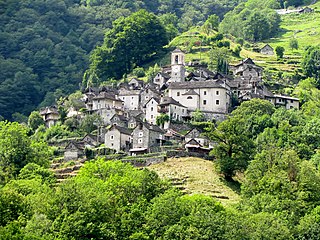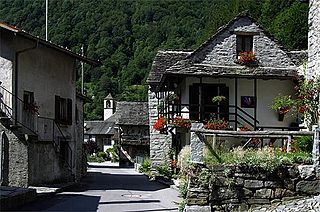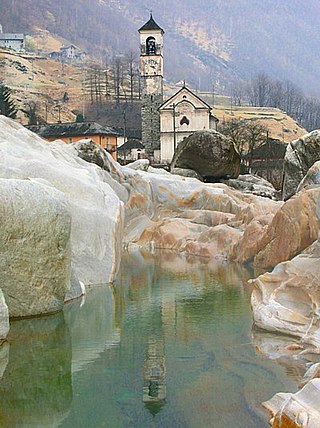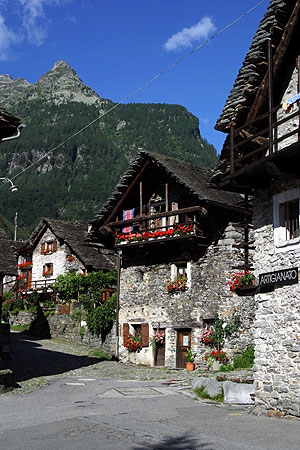
Wolfenschiessen is a village and municipality in the canton of Nidwalden in Switzerland. Besides the village of Wolfenschiessen itself, the municipality includes the settlements of Altzellen, Büren ob dem Bach, Dörfli, and Oberrickenbach, together with a large area of high alpine land, mountains, lakes, and glaciers.

There are 106 municipalities in the canton of Ticino, Switzerland,. Municipalities (comuni) are grouped in circles (circoli) which are part of districts (distretti).

Cugnasco is a village in the municipality Cugnasco-Gerra of the district of Locarno in the canton of Ticino in Switzerland.

Corippo is a village and former municipality in the district of Locarno in the canton of Ticino in Switzerland.

Frasco is a village and former municipality in the district of Locarno in the canton of Ticino in Switzerland. On 17 October 2020 the former municipalities of Vogorno, Sonogno, Corippo, Brione (Verzasca) and Frasco merged to form the new municipality of Verzasca.

Wartau is a municipality in the Werdenberg constituency of the Swiss canton of St. Gallen. The municipality consists of a number of villages on the eastern flank of the Alvier group, along the left shore of the Alpine Rhine.
The Locarno District is a district of Canton Ticino, Switzerland. It has a population of 63,774.

Vogorno is a village and former municipality in the district of Locarno in the canton of Ticino in Switzerland. The village is located above Lago di Vogorno, a reservoir formed by the Verzasca Dam. On 17 October 2020 the former municipalities of Vogorno, Sonogno, Corippo, Brione (Verzasca) and Frasco merged to form the new municipality of Verzasca.

Brione (Verzasca) is a village and former municipality in the district of Locarno in the canton of Ticino in Switzerland. On 17 October 2020 the former municipalities of Vogorno, Sonogno, Corippo, Brione (Verzasca) and Frasco merged to form the new municipality of Verzasca.

Brione sopra Minusio is a municipality in the district of Locarno in the canton of Ticino in Switzerland.

Lavertezzo is a municipality in the district of Locarno in the canton of Ticino in Switzerland.

Mergoscia is a municipality in the district of Locarno in the canton of Ticino in Switzerland.

Minusio is a municipality in the district of Locarno in the canton of Ticino in Switzerland.

Sonogno is a village and former municipality in the district of Locarno in the canton of Ticino in Switzerland. It is located in Valle Verzasca. On 17 October 2020 the former municipalities of Vogorno, Sonogno, Corippo, Brione (Verzasca) and Frasco merged to form the new municipality of Verzasca.

Gerra (Gambarogno) is a former municipality in the district of Locarno in the canton of Ticino in Switzerland.
Gerra (Verzasca) is a part of the municipality of Cugnasco-Gerra in the district of Locarno in the canton of Ticino in Switzerland.
Capriasca is a municipality in the district of Lugano in the canton of Ticino in Switzerland.

The Valle Verzasca is a valley in the Locarno district of the canton of Ticino, Switzerland. It comprises the municipalities of Mergoscia, Vogorno, Corippo, Lavertezzo, Brione, Gerra, Frasco, and Sonogno. As of 2004, the total population is 3,200. It is the most central valley of Ticino, and none of the passes out of the valley cross cantonal or national borders. The valley is formed by the river Verzasca and is situated between the Leventina and the Maggia and culminates at Pizzo Barone.

Cugnasco-Gerra is a municipality in the canton of Ticino, Switzerland. It was formed on January 1, 2009, through the merger of Cugnasco and Gerra.

Gambarogno is a municipality in the district of Locarno in the canton of Ticino in Switzerland. It was created on 25 April 2010 through the merger of the municipalities of Caviano, Contone, Gerra, Indemini, Magadino, Piazzogna, San Nazzaro, Sant'Abbondio and Vira.

























